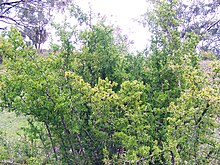Lycium
| Lycium | |
|---|---|
 |
|
| African boxthorn (Lycium ferocissimum) | |
| Scientific classification | |
| Kingdom: | Plantae |
| (unranked): | Angiosperms |
| (unranked): | Eudicots |
| (unranked): | Asterids |
| Order: | Solanales |
| Family: | Solanaceae |
| Subfamily: | Solanoideae |
| Tribe: | Lycieae |
| Genus: |
Lycium L. |
| Species | |
|
About 70-80, see text |
|
| Synonyms | |
|
Cantalea Raf. |
|
About 70-80, see text
Cantalea Raf.
Evoista Raf.
Jasminoides Duhamel
Oplukion Raf.
Panzeria J.F.Gmel.
Teremis Raf.
Lycium is a genus of flowering plants in the nightshade family, Solanaceae. The genus has a disjunct distribution around the globe, with species occurring on most continents in temperate and subtropical regions. South America has the most species, followed by North America and southern Africa. There are several scattered across Europe and Asia, and one is native to Australia.
The generic name is derived from the Greek word λυκιον (lycion), which was applied by Pliny the Elder (23-79) and Pedanius Dioscorides (ca. 40-90) to a plant known as dyer's buckthorn. It was probably a Rhamnus species and was named for Lycia, the province in which it grew. Common names for the genus include box-thorn', desert-thorn, wolfberry, אטד aTaD (Hebrew), and gharqad (Arabic).
There are about 70 to 80 species.
Lycium are shrubs, often thorny, growing 1 to 4 meters tall. The leaves are small, narrow, and fleshy, and are alternately arranged, sometimes in fascicles. Flowers are solitary or borne in clusters. The funnel-shaped or bell-shaped corolla is white, green, or purple in color. The fruit is a two-chambered, usually fleshy and juicy berry which can be red, orange, yellow, or black. It may have few seeds or many. Most Lycium have fleshy, red berries with over 10 seeds, but a few American taxa have hard fruits with two seeds.
While most Lycium are monoecious, producing bisexual flowers with functional male and female parts, some species are gynodioecious, with some individuals bearing bisexual flowers and some producing functionally female flowers.
...
Wikipedia
